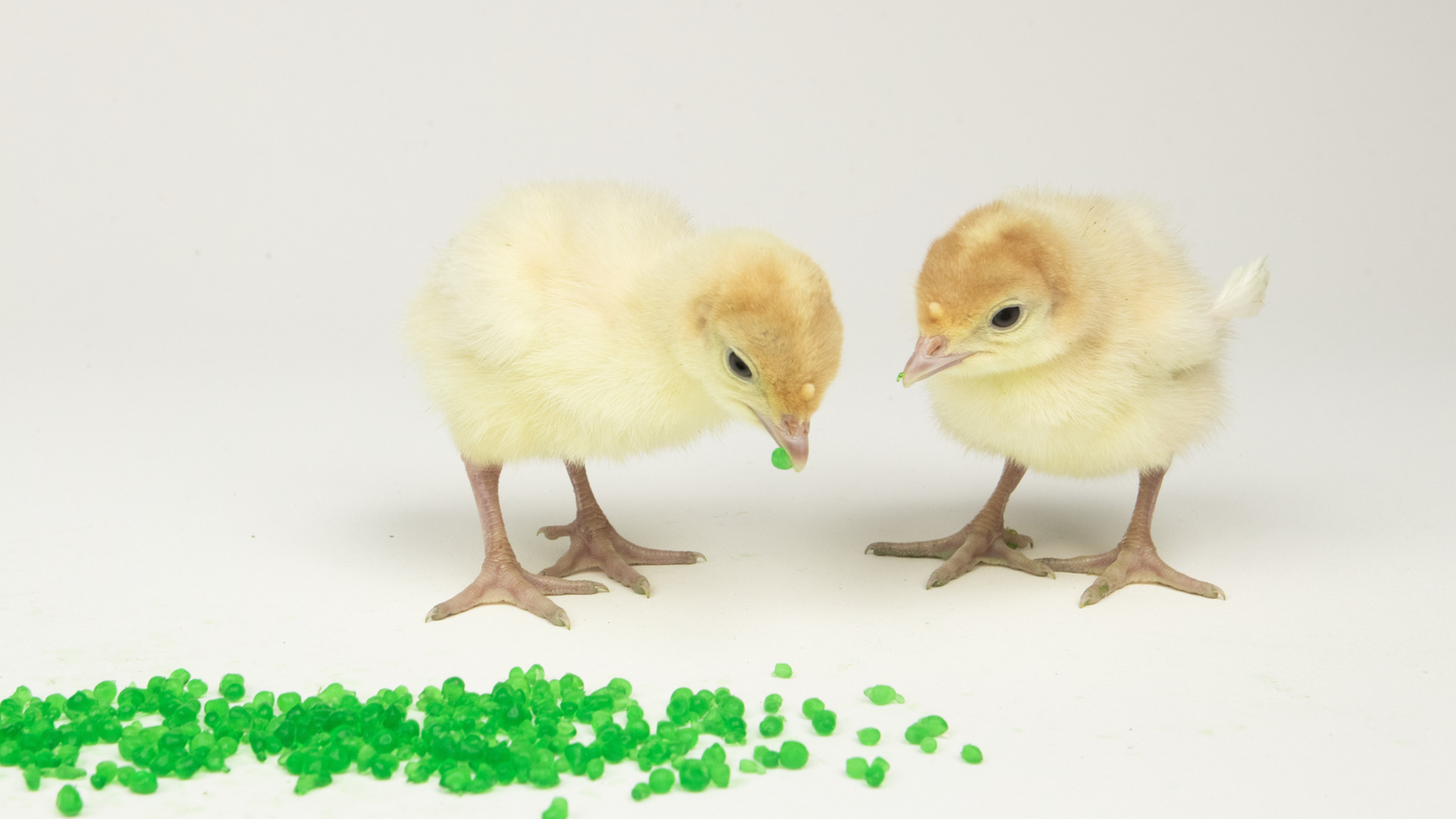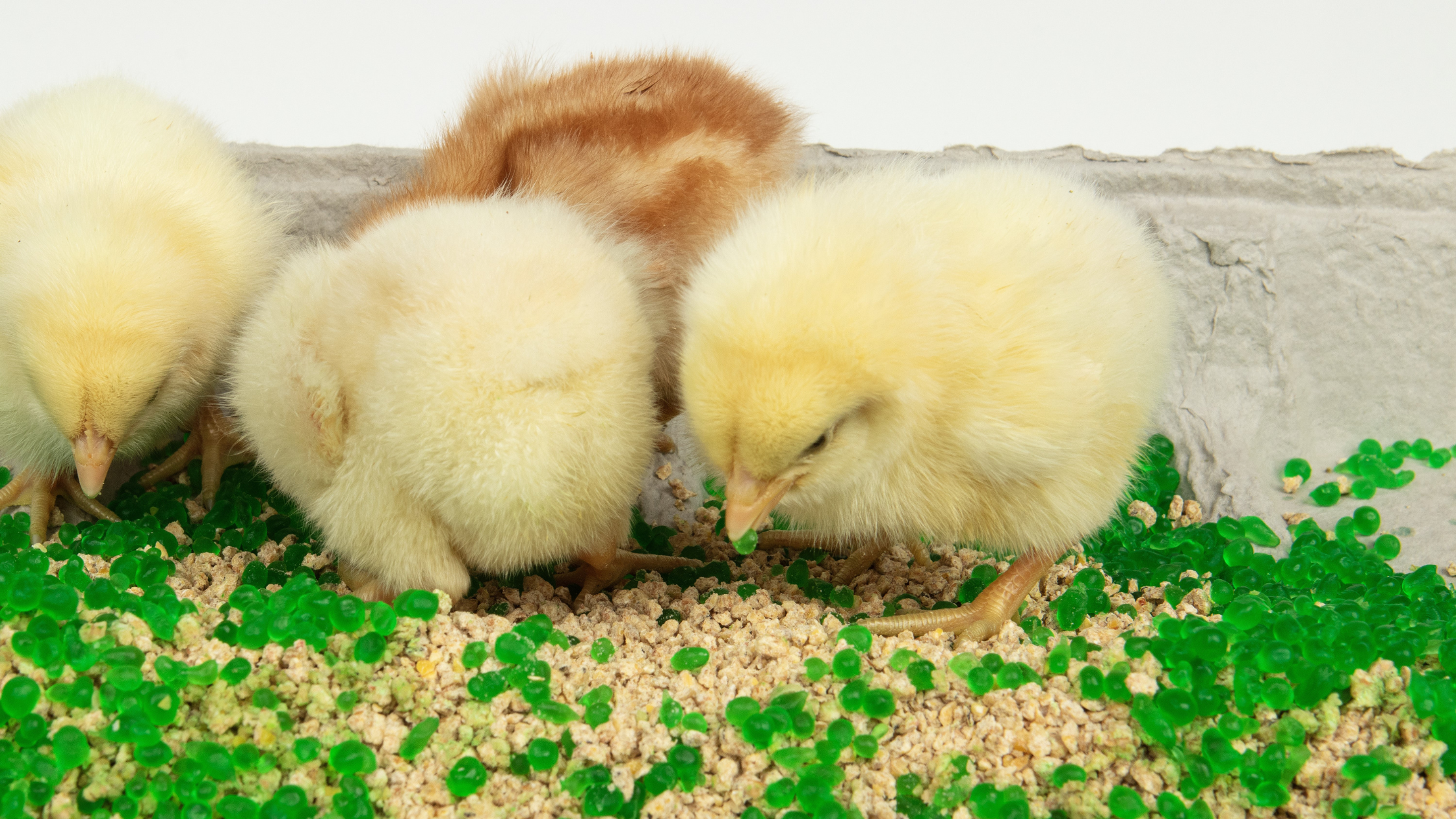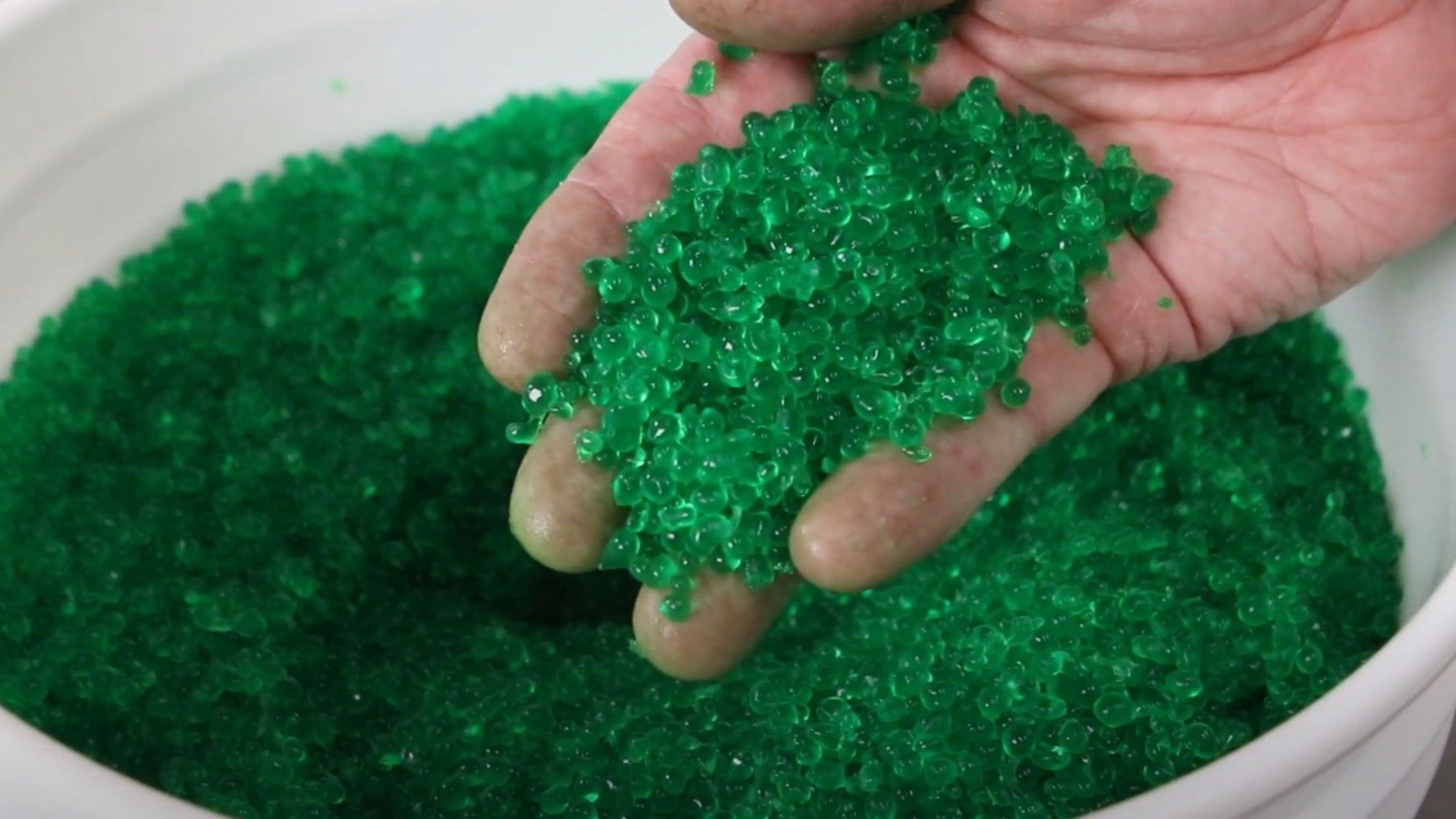Background
This study conducted by the University of Arkansas Division of Agriculture investigated the effectiveness of AquaBeads® as a vehicle for administering the AviPro® Megan® Egg Salmonella vaccine to day-of-hatch turkey poults. The trial evaluated vaccine delivery methods’ impact on body weight (BW), body weight gain (BWG), mortality, and Salmonella colonization.
Experimental Design
The study used 400 day-of-hatch turkey poults (hens) sourced from a commercial hatchery. Upon arrival, poults were wing-banded, individually weighed, and randomly allocated into one of four treatment groups (100 poults per group) with six replicate cages per treatment (10 poults per cage). Each group was assigned a distinct vaccination or vehicle treatment:
Group 1: Non-vaccinated, non-treated control. Poults received feed without AquaBeads® or vaccine exposure.
Group 2: Vaccinated control receiving the AviPro® Megan® Egg vaccine via oral gavage (0.25mL/poult) immediately after placement. Poults were then placed in chick boxes with feed only.
Group 3: Vaccinated using GelPac as a vehicle. The vaccine was applied via a spray to the poults per manufacturer guidelines. Poults were temporarily housed in chick boxes (100 poults/box) where they were allowed to preen to consume the vaccine.
Group 4: Vaccine added to AquaBeads® and mixed per manufacturer instructions. AquaBeads® were applied as a top dressing at a rate of 1.0g/poult (25g total) to feed flats within the chick boxes (25 poults per box). Poults were allowed to consume the AquaBeads® before being transferred.
Key Procedures
- To minimize cross-contamination, Group 1 (non-vaccinated control) was handled separately.
- For Groups 3 and 4, products (GelPac spray or AquaBeads®) were consumed before transferring poults to replicate cages.
- Poult surface temperatures were monitored in Group 3 to account for any potential chilling effect from GelPac application.
- CFU of the vaccine was verified after preparation by sampling mixed products (n=5, 1g per sample in 9mL saline) and performing drop plating on selective and non-selective agar.
Salmonella Analysis
At day 5, cecal and liver/spleen samples were aseptically collected from two poults per cage (12 poults per treatment). Samples were analyzed using microbiological methods, including enrichment in tetrathionate broth, plating on XLT-4 agar, and serotyping for S. Typhimurium to confirm vaccine presence.
Experimental Timeline
Day 0 (December 11): Poults were weighed, wing banded, and assigned to treatments. Groups 2-4 received their respective vaccine/vehicle treatments and were transferred to battery cages.
Day 5 (December 16): Cecal and liver/spleen samples were collected for Salmonella analysis.
Day 7 (December 18): Individual body weights were recorded, and the study was terminated.
Results
Body Weight (BW) and Body Weight Gain (BWG)
By day 7, all vaccinated groups (Groups 2-4) exhibited significantly higher BW and BWG compared to the non-vaccinated control (Group 1). However, no significant differences were observed among vaccinated groups. This indicates that the vaccine and vehicle methods did not impair early growth performance.
| Group | Treatment | Average BW (g) | Average BWG (g) | Mortality (%) |
| 1 | Non-treated control | 120.32 ± 2.38b | 62.98 ± 2.00b | 0/60 (0) |
| 2 | Vaccinated (oral gavage, 0.25mL/poult) | 130.54 ± 2.43a | 72.11 ± 2.26a | 1/60 (1.66) |
| 3 | Vaccinated using GelPac (sprayed onto poults) | 126.08 ± 2.27ab | 69.30 ± 2.24a | 1/60 (1.66) |
| 4 | Vaccinated using AquaBeads® (1.0g/poult) | 127.23 ± 2.27ab | 70.87 ± 2.14a | 0/60 (0) |
Values are expressed as mean ± standard error. a,b indicate significant differences within columns (P < 0.05).
Mortality
Mortality was low and not significantly different across treatment groups, indicating that neither the vaccine nor the delivery vehicles negatively affected poult survivability.
Salmonella Colonization (Cecum and Liver/Spleen)
By day 5, vaccinated groups (Groups 2-4) exhibited significantly higher Salmonella recovery in the cecum and liver/spleen compared to the non-vaccinated control (Group 1). Group 4 (AquaBeads®) had the highest Log10 CFU/g recovery from the cecum, significantly surpassing Groups 2 and 3. Recovery in the liver/spleen was consistent across vaccinated groups, confirming successful vaccine delivery.
| Group | Treatment | Cecum (Log10 CFU/g) | Incidence (%) | Liver/Spleen (Log10 CFU/g) | Incidence (%) |
| 1 | Non-treated control | 0.53 ± 0.36c | 16.6 | 1.35 ± 0.20b | 50 |
| 2 | Vaccinated (oral gavage, 0.25mL/poult) | 5.25 ± 0.21b | 100* | 2.70 ± 0.20a | 100* |
| 3 | Vaccinated using GelPac (sprayed onto poults) | 4.45 ± 0.70b | 83.3* | 2.70 ± 0.20a | 100* |
| 4 | Vaccinated using AquaBeads (1.0g/poult) | 6.53 ± 0.25a | 100* | 2.70 ± 0.20a | 100* |
Values are expressed as mean ± standard error. a,b,c indicate significant differences within columns (P < 0.05). Incidence data were analyzed using chi-square.
Thermal Imaging Results
Thermal imaging conducted post-treatment revealed important insights regarding the impact of vaccination methods on poult surface temperatures and potential stress indicators:
Normal Group (Control): Demonstrated stable surface temperatures, indicating baseline conditions for comparison.

GelPac Group: Thermal images indicated noticeable temperature variations, suggesting potential chilling or stress from the applied spray, which can have implications for animal welfare.


AquaBeads® Group: Thermal imaging indicated stable poult and environmental temperatures similar to control conditions, confirming minimal stress and validating AquaBeads®' non-wetting characteristic and suitability for stress-free vaccine delivery.


Conclusion
This study demonstrates that AquaBeads® can effectively deliver the Megan Egg® vaccine to day-of-hatch turkey poults without compromising growth performance or livability. The AquaBeads® vehicle showed comparable efficacy to oral gavage and GelPac spray methods, with higher Salmonella recovery in the cecum, indicating effective vaccine delivery. Future studies should investigate the long-term impacts of AquaBeads® and optimize administration protocols for broader commercial application.

This research study was conducted at the University of Arkansas, Department of Poultry Science by Danielle Graham, Ph.D., Assistant Professor – Parasitology.




Leave a comment
All comments are moderated before being published.
This site is protected by hCaptcha and the hCaptcha Privacy Policy and Terms of Service apply.